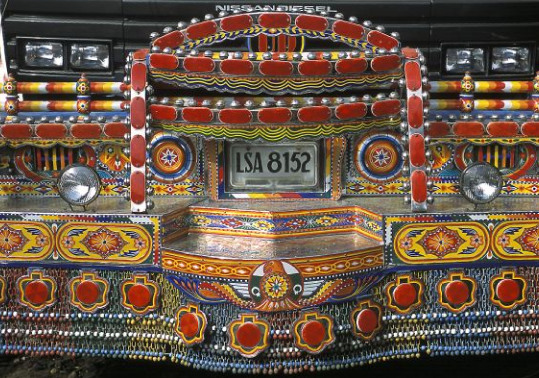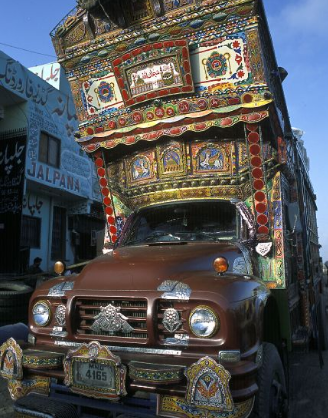If ever I’d wanted to savour the decadence of flying in a private jet, this was it. The F28 seats 78, less one for the flight engineer. I had the choice seat, 1F, right hand window seat, perfect for viewing the Everest. As it turned out, it didn’t matter too much. There were only four other passengers, and we could have taken any seat we chose, left, right, window, and aisle. Had it been a long flight, I would have sprawled across three seats and snored away.Service was excellent. Captain Enam was a photographer and we had fun talking pictures. Never before have I known each passenger in my flight. No queues on arrival, baggage on the belt, even before we’d arrived. Wonderful. Except of course for Biman or the environment. A conservative estimate of a flight to Kathmandu costs Taka 2 lakh. That’s Taka 40,000 per passenger on flight 703. The enormous environmental damage for ferrying five people to a neighbouring country was staggering.
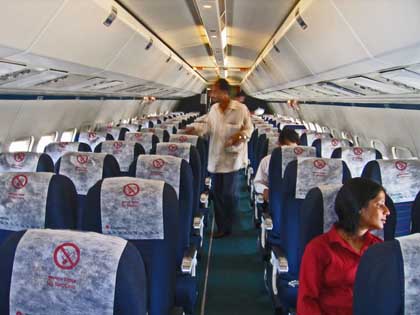
The F28 we were flying was old, water dripped onto the seats, the shuddering panels had withstood daily wear and tear for some 35 years. Still, Bangladesh had paid some nine crore (ninety million) taka for this craft.
I could hear the mumbling in the ground. Cautious comments about how top management never consulted the rest of the staff, how decisions were made on political rather than technical or economic grounds. Rama, a Nepali passenger whose father worked in Cosmic Air commented on how they had expected the flight to be packed because the afternoon flight of Cosmic Air had been cancelled. She was surprised that despite such numbers there were two flights to Kathmandu on the day.
The comments then veered to Biman as a whole. “Amra Borishale batash ani nei” (We only transport air to Barisal and back, there are no passengers), said a Biman official. “Chowdhury shahab er bari Borishale, oi flight ki ar thaman jaibo (Mr Chowdhury the minister- is from Barisal, fat chance you have of stopping those flights).
I enjoyed my flight. I bet the two cockroaches who kept me company did too.
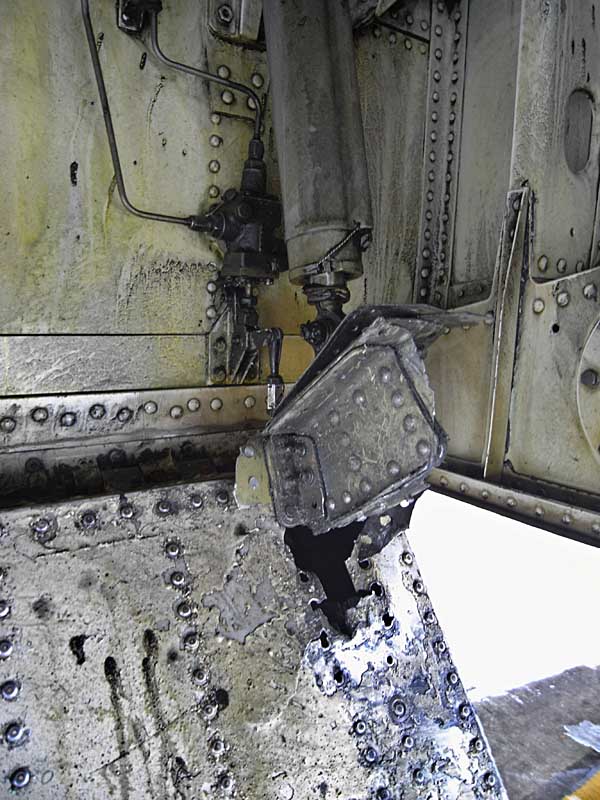
Category: Shahidul Alam
Masterpieces To Go
Another non-terrorist Pakistani story.
Under the shade of a colossal banyan tree, Karachi truck painter Haider Ali, 22, is putting the finishing touches on his latest creation: a side-panel mural of Hercules subduing a lion, rendered in iridescent, undiluted hues of purple, yellow, red and green. His 10-year-old nephew, Fareed Khalid, applies a preparatory undercoat of white paint to the taj, the wooden prow that juts above the truck?s cab like a crown. Like Ali?s father, who first put a brush into his son?s hand at age eight, Haider is carrying on a master-apprentice tradition with Fareed, who spends his afternoons in the painter?s workshop after mornings in school.
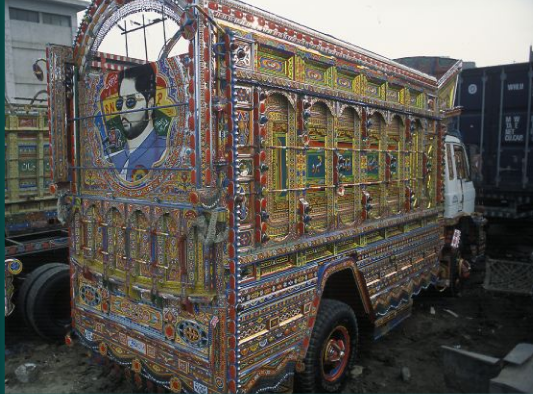
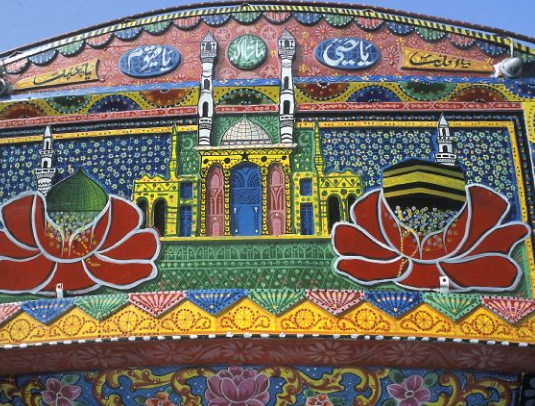
Where Elbows Do The Talking
![]()
It was a mixed week. Sandwiched in between the hartals and the ekushey
barefoot walks and the launch disaster, were news items that led to very
different emotions at Drik. Shoeb Faruquee, the photographer from Chittagong, won the 2nd prize in the Contemporary Issues, Singles,
category of the world’s premier photojournalism contest World Press
Photo. The photograph of the mental patient locked by the legs as in a
medieval stock, is a haunting image that is sure to shake the viewer.
However, the stark black and white image tells a story that is far from
black and white. In a nation with limited resources, medical care for
all is far from reality. Expensive western treatment is beyond the reach
of most, and has often been shown to be flawed. Alternative forms of
treatment is the choice of many. The fact that the boy photographed was
said to have been healed, further complicates the reading of this image.
Shoeb is one of many majority world photographers who have attempted to
understand the complexities of their cultures, which rarely offer
simplistic readings.
It was later in the week, that Azizur Rahim Peu, told me that the
affable contributor to Drik, Mufty Munir, had died after a short illness
at the Holy Family Hospital. I would contact Mufty when I was in
trouble, needing to send pictures to Time, Newsweek or some other
publication. We would work into the night at the AFP bureau, utilising
the time difference, to ensure the pictures made it to the picture desk
in the morning. Occasionally, while hanging out at the Press Club
waiting for breaking news, we would dash off together. Mufty
uncomfortably perched on the back of my bicycle and me puffing away
trying to get to the scene in time.
Wire photography is about speed, and their photographers are known for
being pushy, but this shy, quiet, self effacing photographer made his
way to the top through the quality of his images. We had to push him to
have his first show in 1995, which our photography coordinator Gilles
Saussier and I curated. The show at the Alliance was a huge success, but
Mufty was not impressed by the excitement the show had created. He
simply wanted to get on with his work.
He did have problems with authority, or rather, authority had problems
with him. Despite his shyness, he was a straight talking photographer,
who didn’t hesitate to protest when things weren’t right. Not being the
subservient minion the gatekeepers of our media are accustomed to, he
often got into trouble. But the clarity of his protests played an
important role in establishing photographers’ rights. In the abrasive
world of press photography, where elbows do much of the talking, this
gentle talented practitioner will be dearly missed.
Unknown to the rest of us, the brother of Rob, the gardener at Drik,
died in the launch that sank in the storm at the weekend.
The Land Became The Sea
Subscribe to ShahidulNews
As we watch in horror at the scale of the event, several things come to mind. How events a thousand miles away can affect our lives in so many ways. How connected we are in our joys and our sorrow. I realise that Bangladesh was not as badly affected as our neighbours, and that we should take pride in our achievements, but Bangladeshi newspapers today gloated over the victory of the Bangladeshi cricket team over India in their headlines! While I fret over the fact that the media plays on the negative, to downplay a disaster of such proportions in favour of a cricket match said a lot about our sense of proportions. In 1991, when nearly a million people had gathered to demand the trial of a war criminal, the government had chosen to ignore the news and mentioned instead the man of the match in a cricket game in Shunamganj. I had hoped a free media would play a more responsible role.
As I watch BBC and CNN interview British and German tourists, and the director of Oxfam from her office in Oxford, I remember my experiences in the 1991 cyclone where one hundred and twenty thousand people died in Bangladesh. As I stumbled through the debris, trying to get a sense of what had happened on the night of the 29th April 2001, I kept asking “What happened that night?” The aid workers told me of the number of bags of wheat they had distributed. The government officials quoted the figure in dollars that would be needed for reconstruction, the engineers spoke of the force of the wind.
A young woman in Sandweep looked at me and said “The land became a sea, and the sea became a wave”.
I try to imagine the tsunamis hitting the coasts of India, and Sri Lanka and Indonesia, and remember her words. The thousands whose lives have been wrecked by the earthquake do not constitute the ‘experts’ that the media consider worth asking.
Shahidul Alam
27th December 2004
Dhaka
Chobi Mela III Ends
Subscribe to ShahidulNews
![]()
Well, Chobi Mela III is coming to an end. One of the artists visiting Chobi Mela III was the celebrated Mexican photographer, Pedro Meyer. Pedro is also the editor of one of the most popular websites on photography <
Bangladesh is according to economists, one of the poorest countries in the world. However, statistics tend to also obscure other aspects of life that seem to get lost in such descriptions as “among the poorest in the world”. I found that the people in Bangladesh are among the friendliest I have ever met any place, nothing to say that they must be the biggest enthusiast of having their picture taken that exists on the face of this earth. Probably the most efficient way of getting on with life is, how it is dealt with, in this very poor nation.
This event (Chobi Mela) here, is one of the largest of it’s kind in Asia. Bringing photographers and their work to the forefront during the two weeks of this festival. I have met photographers from all over the region, and I am sure that as this festival grows over the coming years, Bangladesh will increasingly become a major center for the development of photography. And what better place to have such an event than a city, where to such a large extent, photography is welcomed by the population.
Pedro Meyer left day before yesterday, Raghu Rai left yesterday, Ozcan Yurdalan left this morning, while Zhuang Wubin is still out there somewhere in Sylhet. The exhibitions by Morten Krogvold, Michel Szulc-Krzyzanowski, Srinivas Kuruganti (Alliance Fran?aise), John Lambrichts (Goethe Insitut), Raghu Rai (Drik Gallery One), Darren Soh, Student?s of Morten?s workshop, Zhuang Wubin and Chris Yap (Drik Rooftop Gallery) all end today. We will arrange separate showings for ?Bridging East and West?, by Saudi Aramco World, which was held up by customs, and the exhibition by students of Barbara Stauss at a later date. Those of you who cannot make it to the galleries should give your eyes a feast at <http://www.chobimela.org/> www.chobimela.org.
Shahidul Alam
I Will Not
Subscribe to ShahidulNews
Today on Earth Day we are celebrating by making promises
But I will not
I will not stop throwing paper on the ground.
I will not stop using plastic bags
I will not go to clean the beaches
I will not stop polluting
I will not do all these things because I am not polluting the world
It is the grown-ups who are dropping bombs
It is the grown-ups who have to stop
One bomb destroys more than all the paper & plastic that I can throw in all my life
It is the grown-ups who should get together and talk to each other
They should solve problems and stop fighting and stop wars
They are making acid rain and a hole in the ozone layer
I will not listen to the grown-ups!
[Student of class five of Karachi High School on Earth Day 1991].
It was in the wee hours of the morning. Propped up in our beanbags Nuzhat and I chatted while Zaheer and Ragni clicked away on their keyboards. I was in Karachi doing a story on Abdul Sattar Edhi, the philanthropist I admired greatly. Nuzhat and I had a lot of catching up to do, and our stories wandered in unplanned directions. We talked of when she and Nafisa Hoodbhoy had started the Peace Committee in Karachi and as she remembered this story her bright eyes welled up. Nuzhat was not the sort of person one could imagine being angry. But as she recalled the words of this little boy, she shook with emotion.
It was a week after they had heard the news of the US dropping a bomb every two minutes on Iraq. They had talked in school of how the world was being destroyed, of how the minds of people were being moulded, of how Pakistanis were looked upon at airports, but how the work of Edhi went unreported. She recalled how at the end of her talk, the chief guest, a woman known for her good work, went up to the boy and quietly told him off. How the prizes went to the other kids who had made presentations that no one could remember.
What can we say to the blind & deaf?
What does education & learning mean?
What should we teach & why do we teach it?
These were questions Nuzhat asked that night. Questions we continue to ask.
As we put together the work for this festival, I have marvelled at the range of statements the artists have made to address ?resistance?. At their modes of expression. At their defiance. To resist, to challenge, to question, to go against the grain, to deliberately choose the untrodden path is a conscious decision. It is a risky route fraught with danger, but a route we must follow, if change is to come.
The festival itself continues to buck the trend. Open air marquees without gates or walls bring rarely seen work to a wider public. Billboards on cycle rickshaws take exhibitions to city spaces that have never known gallery walls. Combining innovative low cost solutions with state of the art technology, video conferences link the virtual with the real, while canvas prints on giant scaffolding scorn the air conditioned confines of exclusive openings. Hand tinted prints rub shoulders with pica droplets on digital media. Fine art, conceptual work, installations, traditional photojournalism, coexist in a strange mix, oblivious to attempts to categorise and label. The future, the present and the past huddle, sometimes uncomfortably, to produce a kaleidoscope of images and woven messages, that question, reflect and celebrate aspects of our existence.
When globalisation has become a euphemism for westernisation, it is this dissolution of borders, this resistance to consumerism, this dream of a world where the might of a few, can be effectively challenged, this belief that tanks and stealth aircraft, and media spin will not subdue an indomitable spirit, that characterises this festival. It is this attempt to subvert, through blogs and handbills and word of mouth, the propaganda machineries that dominate the airwaves, that the artists have taken as their inspiration. The festival is a call to resist, and a declaration of the resistance to come.
Shahidul Alam
5th December 2004
Identity Card
Subscribe to ShahidulNews
The mail today brought a copy of ?Amader Kotha?. A publication by the American Center in Dhaka. The lead article in this unsolicited newsletter by Abu Naser was entitled ?An International Election in November: A chance for Bangladesh to learn about democracy?. As I landed at Zia International Airport yesterday, my colleague Tanvir, told me of the gunning down of the opposition MP the day before. At night I stopped the rickshaw to photograph the burning cars in the streets. The violence, the protests, the despair, is all too familiar. We saw it during military rule and during all the subsequent regimes. Abu Naser rightly, points to failures in the democratic process in Bangladesh. But to learn about the democratic process from the US! Perhaps it had to do with Rumsfeld?s claim that their failed cover up of military atrocities was evidence of a healthy democracy. Their previous ?exemplary? election is perhaps better left unmentioned.
I remember the surprise in the media in the UK, aghast at what was being reported from Iraq. It is hardly as if this had not been known before, by anyone who might have cared to listen. I am less surprised, when the confirmed atrocities by US soldiers, is suddenly seen as something done by them out there. No talk of coalition forces this time. No talk of united responsibilities, or united blame. I am not surprised when the assassinations in Palestine resulted in merely the predictable ?condemnation? by the UN and western nations. ?Tut tut, you mustn?t do that you know!?
I see the fire raging around me and throughout the globe and remember Mahmoud Darwish?s anger.
Shahidul Alam
Dhaka. May 10th 2004
Identity Card
Write down!
I am an Arab
And my identity card number is fifty thousand
I have eight children
And the ninth will come after a summer
Will you be angry?
Write down!
I am an Arab
Employed with fellow workers at a quarry
I have eight children
I get them bread
Garments and books
from the rocks..
I do not supplicate charity at your doors
Nor do I belittle myself at the footsteps of your chamber
So will you be angry?
Write down!
I am an Arab
I have a name without a title
Patient in a country
Where people are enraged
My roots
Were entrenched before the birth of time
And before the opening of the eras
Before the pines, and the olive trees
And before the grass grew
My father.. descends from the family of the plow
Not from a privileged class
And my grandfather..was a farmer
Neither well-bred, nor well-born!
Teaches me the pride of the sun
Before teaching me how to read
And my house is like a watchman’s hut
Made of branches and cane
Are you satisfied with my status?
I have a name without a title!
Write down!
I am an Arab
You have stolen the orchards of my ancestors
And the land which I cultivated
Along with my children
And you left nothing for us
Except for these rocks..
So will the State take them
As it has been said?!
Therefore!
Write down on the top of the first page:
I do not hate poeple
Nor do I encroach
But if I become hungry
The usurper’s flesh will be my food
Beware..
Beware..
Of my hunger
And my anger!
An extract from the text of the Berlin Festival Appeal:
“Mahmoud Darwish was one of the best-loved Arab poets of modern times and counts among the most eminent poets in the history of world literature. Thousands flocked to hear his readings, and his volumes of poetry have been published in the hundreds and thousands. Numerous pieces have been translated into more than 30 different languages. His poems have been transformed into folksongs and many of his verses have taken on the character of proverbs.
Darwish‘s poetry draws inspiration from the tradition of ancient Arab poetry and Modernist influences and borrows from the style and language of both the Qur’an and the Bible. Few other poets have displayed such dedication to articulating a vision of a meaningful, real and fair peace between Arabs and Israelis, which furthers a dialogue between two voices and two different outlooks on life, while ensuring that one does not impose its view upon the other.
In the tradition of ancient Arab poetry, the poet assumes the role of spokesperson for his people. And despite Darwish‘s move away from this role since the 1990s, many readers still viewed him as Palestine’s literary ambassador to the last.
Mahmoud Darwish was born in 1941 in the village of Al-Birweh near Acre. In 1948, he fled to Lebanon and returned after the foundation of the state of Israel. He worked as an editor for various political and cultural journals in Haifa. After being imprisoned on numerous occasions, he left Israel in 1970 and went into exile. He has lived in Moscow, Cairo, Beirut, Paris and, most recently, in Amman and Ramallah. In 1987, he was elected to the executive committee of the Palestine Liberation Organization and helped draft the Palestinian Declaration of Independence in 1988. He left the organization in 1993 in protest against the signing of the Oslo Accords. He received numerous awards, including the Lannan Prize for Cultural Freedom in 2001 and the Erich Maria Remarque Peace Prize in 2003.
Darwish died on 9 August 2008 following heart surgery. He was buried in the West Bank city of Ramallah and granted a state funeral.”
—
Gallerie Publishers
208 Om Chambers
Kemps Corner
Mumbai 400036
India
————————————————————————————
Mahmoud Darwish 1942 – 2008
Debunking the Expert Myth
Subscribe to ShahidulNews
![]()
Experts determine our lives. They decide what we should wear, who we should have as partners, how many children we should have, who we should take loans from. They determine the very characteristics of a ‘civilised society’.
Seven years after I wrote the original piece, this video further cracks the expert myth. A three part series.
—————————————————-
Journalists too fall into the category of ‘experts’, and have considerable clout. While ‘expertism’, which works to preserve the power structures within society, is a trap a concerned journalist will be wary of. There are those within the media, who use the extra clout of a press pass to obtain favours, and use their expert status to sell ideas to a misinformed public.
A journalist’s job is to explain, in simple terms, complex issues in a manner, which is compelling, engaging and meaningful to people, to debunk expertism. In order to do so she needs to gather a fair amount of knowledge on the area of expertise that she reports on. She needs to wade through the jargon, to get to the essential facts. She needs to make sense of numerical data, and have enough rigour in her analysis so it can stand up to intense scrutiny. She needs to interpret things in language that is commonly understood, and to be aware of the cultural contexts that may give altered meanings. Here lies a trap, for in this process of simplification, she may choose metaphors, which may not be wholly accurate; she may leave out data, which may be pertinent; and she may shift emphasis, to make a point. Her position wields immense power. As a knowledge broker she can influence people’s opinion. Her politics may determine the course of social action.
Power of Culture: Bangladeshi Spirit
Subscribe to ShahidulNews
![]()
Over the years, February has become our month of resistance. This is the window that successive repressive governments have allowed us, to vent our steam. The open air plays in Shahid Minar, the book fare in Bangla Academy and of course the midnight walk and the songs of freedom on the night of Ekushey, the 21st February, are all tolerated, for one month.
Yuppie Bangladeshis put on their silk punjabis and saffron sarees, and become the torch bearers of our heritage, for one month. Come March, it will be business as usual. It has been difficult convincing development experts of the value of culture in our society. With ‘poverty alleviation’ being the current? buzzwords, one forgets, that it was the love for our language that shaped our resistance in ’71 or that ‘Bangla Nationalism’ has been used to justify repression in the Chittagong Hill Tracts. On the 1st February, perhaps we could look back at a collaboration between Drik in Bangladesh, and Zeezeilen in the Netherlands:
Power of Culture: Bangladeshi Spirit
Culture glides through peoples’ consciousness, breaking along its banks, accumulating and depositing silt, meandering through paths of least resistance, changing route, drying up, spilling its banks, forever flowing like a great river. Islands form and are washed away. Isolated pockets get left behind. It nurtures, nourishes and destroys. Ideas move with the wind and the currents and the countercurrents. Trends change, flowing in the slipstreams of dominant culture. A few swim against this current, while others get trapped in ox-bow lakes, isolated from the mainstream.
Photography, more than any other media or art form has influenced culture. Photographs in particular take on the dual responsibility of being bearers of evidence and conveyers of passion. The irrelevant discussion of whether photography is art has sidelined the debate from the more crucial one of its power to validate history and to create a powerful emotional response, thereby influencing public opinion. The more recent discussions, and fears, have centred on the computer’s ability to manipulate images, subsuming the more important realisation that photographs largely are manufactured by the image industry, one that is increasingly owned by a corporate world. The implied veracity of the still image and its perceived ability to represent the truth hides the ubiquitous and less perceptible manipulation enabled by photographic and editorial viewpoint. Not only can we no longer believe that the photograph cannot lie, we now need to contend with the situation that liars may own television channels and newspapers and be the leaders of nations. Given the enormous visual reach that the new technology provides, the ability to lie, is far greater than has ever been before.
Photography has become the most powerful tool in the manufacturing of consent, and it remains to be seen whether photographers can rise above the role of being cogs in this propaganda machine and become the voice for the voiceless.
World Press Photo In Dhaka: Behind The Scenes
![]()
With hundreds of people seeing the show every day, and excellent media
coverage, it might appear as if the staging of WPP photo in Bangladesh was a
smooth well organised affair. As Marc will testify, the reality was very
different. For those of you who have seen the show at the gallery or online,
this behind the scenes look will provide an amusing take on a potential
disaster.
The crates had arrived at Zia International Airport on the 24th of December
2003, but the journey from Zia to Dhanmondi took considerably longer. The
opening was at 4:00 pm on the 7th January 2004. By 3:30 pm, the crates
hadn’t arrived! We did know they had left the airport, and was able to tell
the Dutch Ambassador that it was safe for him to come over. The head of the
caretaker government, our chief guest, Justice Habibur Rahman was already on
his way. The adrenaline was flowing!

